 |

|
YUMA AREA DESERT PLANTS |
| ROADSIDE FLOWERS IN YUMA |
| Most of the year the desert seems barren and
desolate. But in early February, hints of new life begin to appear. Colors reach full
bloom from mid-March to mid-April; most trees flower from April to May. Wildflowers
respond to the amount of moisture during winter. Wet winters yield a bounty of flowers and
turn a usually brown hillside into a bright green. As you travel through Yuma, look for
these common flowers. Travelers along the major roadways may see: |
| Desert Lily - Resembling the Easter
Lily, this white flower on a tall stem is typically found in sandy soils. The early
Spanish explorers called it "ajo" meaning garlic, for its onion flavored bulb. |
Purple Threeawn - Actually, a tall
grass, this plant grows in bunches along roadsides and other disturbed areas. It is named
for the three purplish spikes or awns that grow from each seed head. |
| Desert Marigold - Common in disturbed
areas like roadsides, these bright yellow daisy-like flowers are borne on tall stalks
above wooly grey-green foliage. |
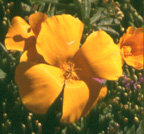 Mexican Poppy
- These showy orange to gold flowers are easily recognized by their four-petal poppy
flowers. Mexican Poppy
- These showy orange to gold flowers are easily recognized by their four-petal poppy
flowers. |
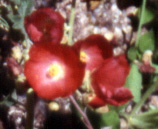 Desert Mallow - Delicate,
cup-shaped apricot to orange colored flowers bloom in clusters on multiple stems up to 3
feet tall. The leaves are covered with white hairs that can irritate your eyes, giving
this plant its local name, "sore-eye poppies". Desert Mallow - Delicate,
cup-shaped apricot to orange colored flowers bloom in clusters on multiple stems up to 3
feet tall. The leaves are covered with white hairs that can irritate your eyes, giving
this plant its local name, "sore-eye poppies". |
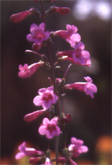 Penstemon -
The tiny tubular-shaped rose-colored flowers look like miniature snapdragons on tall
stalks. Light green, arrow-shaped leaves are borne in pairs on the stems. Penstemon -
The tiny tubular-shaped rose-colored flowers look like miniature snapdragons on tall
stalks. Light green, arrow-shaped leaves are borne in pairs on the stems. |
| Desert Sand Verbena - A low-growing
plant, the small lavendar tubular flowers grow in clusters on trailing stems. This
fragrant plant prefers sandy flats or dunes. |
Lupine - This plant often grows in
masses along roadsides. Purplish-pink to violet pea-shaped flowers are borne on one foot
tall spikes. Leaves are palmate or finger-shaped, extending in a circle from a central
point. |
| SHRUBS |
 Brittlebush -
This common low shrub is one to three feet tall and has silvery-white mounds of foliage
with bright sunflower-yellow blossoms. Its Spanish name, "Incienso", comes from
the chrystaline resin exuded from its stems that was burned as incense by early
missionaries. Brittlebush -
This common low shrub is one to three feet tall and has silvery-white mounds of foliage
with bright sunflower-yellow blossoms. Its Spanish name, "Incienso", comes from
the chrystaline resin exuded from its stems that was burned as incense by early
missionaries. |
 Creosotebush
- The most common shrub in the lower Sonoran Desert, this three to six-foot tall plant
is brightened by its yellow flowers in spring. Flowers are later replaced by fuzzy white
seed heads. The plant's strong, resinous odor is similar to creosote, giving this shrub
its name. Creosotebush
- The most common shrub in the lower Sonoran Desert, this three to six-foot tall plant
is brightened by its yellow flowers in spring. Flowers are later replaced by fuzzy white
seed heads. The plant's strong, resinous odor is similar to creosote, giving this shrub
its name. |
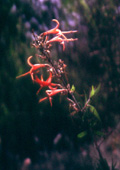 Chuparosa -
Also known as the hummingbird bush, this shrub's tubular red flowers are a favorite source
of nectar and insects for hummingbirds. Growing up to six feet tall, this sprawling shrub
is found along washes. Chuparosa -
Also known as the hummingbird bush, this shrub's tubular red flowers are a favorite source
of nectar and insects for hummingbirds. Growing up to six feet tall, this sprawling shrub
is found along washes. |
Beavertail - This cactus is named for
its flat, oval-shaped pads. The pads lack the long spines common to the prickly pear, but
have tiny glochids, hard to remove if touched. It bears brilliant magenta flowers and is
usually found on rocky hillsides. |
| Ocotillo - One of the oddest looking
shrubs in the southwestern deserts, this tall plant is formed of spike-like canes that
look dead most of the year. After rains, bright green leaves cover the thorny stems and
are followed by a cluster of scarlet flowers at the top of the stems. |
|
| TREES |
| Palo Verde - Palo verde means
"green stick". This tree is easily identified by its green trunk and branches,
where 40 percent of the plant's photosynthesis takes place. It is covered with delicate
flowers in the spring. |
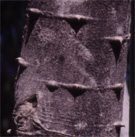 Cat's Claw - Photo shows "cat claws" on trunk. Cat's Claw - Photo shows "cat claws" on trunk.
Also called a "wait-a-minute bush", this is a common shrub or small tree along
washes. The leaves are similar to but smaller than those of the Mesquite, and this plant
has a single cat claw-shaped spine rather than paired straight spines. The puffy yellow
flowers look like balls of cotton and are followed by four to five inch long bean pods. |
| Ironwood - The dense wood from this
tree is often used for carving in Mexico. This majestic tree grows along washes and blooms
with reddish- purple flowers in May. The pods contain edible beans that, when roasted,
have a peanut like flavor. |
Smoketree - A small tree growing up to
20 feet tall, the branches are usually leafless and greyish green, giving the tree its
smoky appearance. In May to June it is blanketed with dark blue flowers. It grows in
frost-free areas of the desert along washes. |
| For information contact: Bureau of Land Management — Yuma
District (928)317-3200
2555 Gila Ridge Road - Yuma, Arizona 85365 |
 |
 |
 |
 |
 |
 |
 |
 |
 |
 |

![]()
 Mexican Poppy
- These showy orange to gold flowers are easily recognized by their four-petal poppy
flowers.
Mexican Poppy
- These showy orange to gold flowers are easily recognized by their four-petal poppy
flowers.